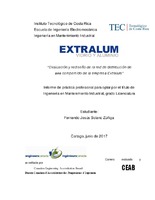Evaluación y rediseño de la red de distribución de aire comprimido de la empresa Extralum
Abstract
Currently, companies are in search of the continuous improvement of their production lines; this is why companies like Extralum seek to maximize the efficiency of their systems in order to increase their productivity and reduce costs; so in this project the current compressed air network is evaluated in order to carry out a redesign that optimizes the efficiency of the system. Firstly as in all redesign it is vital to know the current state, so that as a prelude to the project is carried out a survey of the compressed air network. This provides a basis for observing the current scenario and knowing the locations of consumer teams. On the other hand, the leaks present in the network corresponding to 1,88 𝑚3/𝑚𝑖𝑛, and the system load loss 8,33% above the recommended 4% Next, the equipment consumptions are determined in two ways, the first one making site measurements of the main outputs and the second, in the case of the pistons, theoretically. By means of the study, it was determined that at present the maximum flow rate is 7,85 𝑚3/𝑚𝑖𝑛 with 23,9% of leaks so it should be reduced, while the proposed design flow with a 15% leaks and with a magnification factor of 15% corresponds to 7,76 𝑚3/𝑚𝑖𝑛 Subsequently we entered the design stage where we propose a new distribution of the compressed air network. It proposes variations in pipe diameters, installation of new equipment among other variables. Finally, an economic study is carried out in order to support the project where a project NPV of $ 27 677 is obtained and a 30,2% IRR is evaluated by the 10-year project and obtaining a return on investment within a period of 5 years. In addition to this, the project is supported by the identification of energy conservation opportunities that together with the redesign of the network allows to reduce operating expenses and improve the productivity of the system.
Description
Proyecto de Graduación (Licenciatura en Mantenimiento Industrial) Instituto Tecnológico de Costa Rica, Escuela de Ingeniería Electromecánica, 2017.


